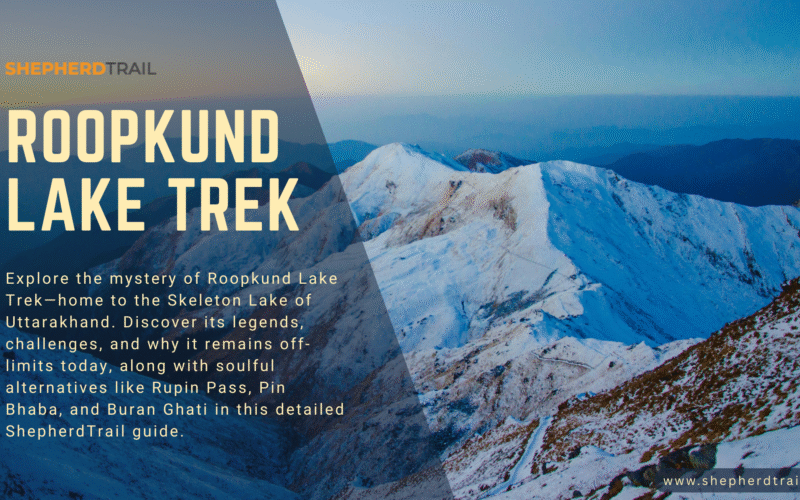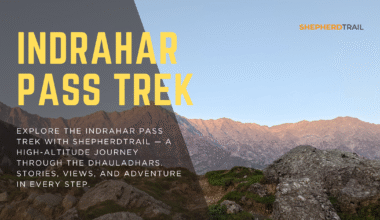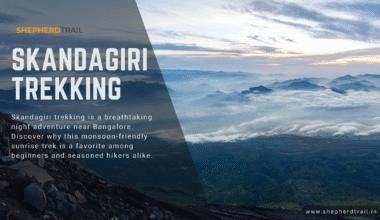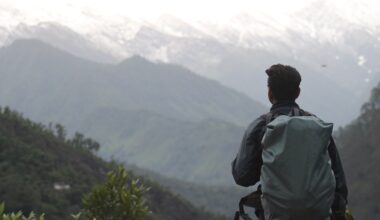🏔️ Roopkund Lake Trek – The Mysterious Trail of Skeletons and Splendor
By ShepherdTrail – Where Every Trail Tells a Story
🌄 Where Legends Sleep Beneath the Ice
High up in the Garhwal Himalayas lies a glacial lake cloaked in mist, mythology, and mystery—Roopkund Lake. Often called the Skeleton Lake, Roopkund sits silently at an altitude of 5,029 meters (16,500 ft), surrounded by towering peaks like Trishul and Nanda Ghunti. What makes this trek legendary isn’t just the surreal views, but the eerie presence of hundreds of ancient human skeletons at the lakebed, visible when the ice melts.
For generations, this has stirred the imagination of trekkers, anthropologists, and adventurers. But beyond the intrigue, Roopkund Lake Trek is a spiritual and scenic journey through oak forests, highland meadows (Bugyals), and snowy ridgelines.
Yet, as of now, the trek remains under restriction, and trekking beyond Bedni Bugyal has been banned due to ecological concerns. So we’re here to tell the tale, share why this trek still lingers in every trekker’s heart, and offer worthy alternatives.
📍 Roopkund Lake Trek – Key Highlights
- Altitude: 5,029 meters (16,500 ft)
- Region: Chamoli district, Uttarakhand
- Trek Distance: ~53 km round trip
- Duration: 7–9 days
- Best Season: May–June, September–October
- Start Point: Lohajung
🧭 A Trail Etched in Myth and Ice
The Roopkund trail isn’t just a hike—it’s a storybook. Starting from the charming village of Lohajung, the trail ascends gradually through mixed forests of rhododendron and oak to the famous alpine meadows of Bedni Bugyal. Here, the snow-capped peaks begin to command the skyline, and the atmosphere turns meditative.
Before the restrictions, trekkers would push ahead to Pathar Nachauni, Kalu Vinayak, and then the final climb to Roopkund. As you stood at the frozen lake, the skeletal remains greeted you—not in horror, but in humility, as if reminding us of the fragile, fleeting nature of life.
According to local folklore, these remains belong to a royal entourage caught in a hailstorm centuries ago. Recent studies suggest the skeletons are from multiple groups, spread across centuries.
🌿 Why the Ban? The Fragile Beauty Needs Protection
Roopkund became immensely popular in the 2010s, drawing thousands of trekkers annually. This surge, while economically beneficial to locals, had a severe ecological impact—erosion, waste buildup, and trail degradation.
In 2018, the High Court of Uttarakhand imposed restrictions, halting camping beyond Bugyals like Bedni and Ali. The region is ecologically sensitive, home to rare alpine flora, and culturally sacred to locals.
So while you can still trek up to Ali and Bedni Bugyal, Roopkund itself remains out of bounds. But don’t worry—the journey till the Bugyals is still soul-stirring, and alternatives exist that offer equal adventure.
🏕️ The Journey (Up to Bedni Bugyal)
Day 1: Drive from Rishikesh/Haridwar to Lohajung (220 km)
A long but scenic drive. You’ll pass through Devprayag and Karnaprayag, watching rivers merge and mountains grow.
Day 2: Trek from Lohajung to Didna (8 km)
A gradual trek through forest and quaint villages. Spend the night in a local homestay or tented accommodation.
Day 3: Didna to Ali Bugyal (10 km)
Climb up through oak and rhododendron forests. Suddenly, the forest opens into a vast meadow—Ali Bugyal—one of the most picturesque campsites in the Indian Himalayas.
Day 4: Ali Bugyal to Bedni Bugyal (4 km)
A leisurely walk across rolling meadows. The peaks of Nanda Ghunti and Trishul seem close enough to touch.
Day 5: Descend to Lohajung or extend to nearby villages
Since Roopkund is off-limits, you may choose to descend or spend an extra day exploring local life around Wan or Mundoli.
🧳 Trail Tip: Even though the full trek is restricted, the experience till Bedni Bugyal offers enough beauty to make the trip worth it. You’ll still cross streams, camp under starlit skies, and walk through some of the finest Bugyals in India.
🧘 Spiritual Significance
Roopkund isn’t just another frozen lake—it sits in the lap of Nanda Devi Raj Jat Yatra route, a sacred pilgrimage that occurs every 12 years. The local communities revere the lake and the surrounding meadows as spiritual grounds.
Even the famous Bhojpatra (Himalayan Birch), once used for scriptures and rituals, grows in nearby alpine zones. While it’s illegal to collect or damage these trees today, spotting one on the trail feels like finding a relic of Himalayan wisdom.
🔄 Alternatives to Roopkund Trek (Equally Magical, Currently Accessible)
Since Roopkund is out of bounds, here are three alternatives that carry the same spirit of adventure:
🏞️ 1. Rupin Pass Trek
- Region: Uttarakhand–Himachal Border
- Altitude: 4,650 meters
- Highlights: Waterfalls, hanging villages, snow bridges, and the dramatic pass crossing
- Why it’s a great alt: Scenic variation and a strong cultural element with manageable challenges
🏔️ 2. Pin Bhaba Pass Trek
- Region: Kinnaur to Spiti (Himachal Pradesh)
- Altitude: 4,915 meters
- Highlights: The shift from green Kinnaur to barren Spiti, river crossings, and high-altitude desert
- Why it’s a great alt: Offers Roopkund-like remoteness with even more contrast. Read more about this here.
🏕️ 3. Buran Ghati Trek
- Region: Himachal Pradesh
- Altitude: 4,550 meters
- Highlights: Snow walls, alpine lakes, meadows, and rappelling sections
- Why it’s a great alt: Offers everything—from forests to ice walls—in one compact package
🧗 Should You Still Do the Bugyals?
Absolutely. If you’re someone who loves:
- Wide open alpine meadows
- Solitude and soft trails
- A blend of natural beauty and cultural depth
Then a 3- to 5-day trip to Ali and Bedni Bugyal still makes for an unforgettable Himalayan escape.
🧰 Quick Tips for Trekking in Uttarakhand (Especially Monsoon/Post-Monsoon)
- Acclimatization: Spend a night in Lohajung or Wan before starting
- Hydration: Drink water even if you’re not thirsty
- Footwear: Carry high-ankle waterproof trekking shoes
- Guide/Porter: Hire locals through platforms like Campshala
- Network: Patchy after Lohajung. Airtel/BSNL may work
- Permissions: Required beyond certain altitudes – mostly managed by trek operators
🚫 Things to Avoid
- Trekking solo without informing authorities
- Leaving behind plastic waste
- Disturbing local shrines or collecting Bhojpatra
- Camping near water sources
🏞️ Final Thoughts – Let the Spirit of Roopkund Live On
While the original Roopkund Lake trek may no longer be accessible, its spirit remains alive in every trekker who dreams of misty ridges, alpine silence, and stories buried in snow.
At ShepherdTrail, we believe the trail is not just about the destination, but about what it reveals in us. Be it Bedni’s silence, Buran’s drama, or Rupin’s thunder, the Himalayas still whisper secrets to those who listen.
Let Roopkund inspire your next adventure—even if it takes you somewhere else.
📞 Plan Your Adventure
Book your next trek with certified local guides and curated itineraries:
👉 Call/WhatsApp: 7340973455
🌐 Visit: www.shepherdtrail.in
ShepherdTrail – Where Every Trail Tells a Story







